
Super 8

 -- W h a t i s S u p e r 8? --
So, what is super 8 you ask? Technically Super 8 is a 8mm wide
piece of film. But to some it is much more. In the right hands
it becomes an art form. A way to express ideas, thoughts, and
feelings.
"Many of today's great cinematographers and directors began
their careers decades ago, at the counter of their local
photo shop, buying a cartridge of Super 8 film."
- Kodak's Super 8 Web Site
"If a picture is worth a thousand words,a motion picture
must be worth 10 times that"
- Jason Publack
-- W h a t i s S u p e r 8? --
So, what is super 8 you ask? Technically Super 8 is a 8mm wide
piece of film. But to some it is much more. In the right hands
it becomes an art form. A way to express ideas, thoughts, and
feelings.
"Many of today's great cinematographers and directors began
their careers decades ago, at the counter of their local
photo shop, buying a cartridge of Super 8 film."
- Kodak's Super 8 Web Site
"If a picture is worth a thousand words,a motion picture
must be worth 10 times that"
- Jason Publack
-- T h e H i s t o r y --
Super 8 film was the thing to use in the '70s
and '80s, there were no video cameras, so super
8 was the only real choice. Since then super 8
has been retired to the back of the closet. However,
Super 8 appears to be making a come back, and
if you still use s8 this page is for you. In
1965 Kodak came out with their new 8mm film,
the called it Super8. In the beginning it was
a silent format. The new film came in 50 or 200
foot cartridges, the fifty foot cartridge only
lasted 3 minutes and 20 seconds. Later several
company's introduced it with magnetic sound,
and then nearer to the '90s those company's stoped making s8
 leaving only Kodak. Kodak has since stopped production of sound
cartridges and alot of their Kodachrome and Ektachrome
lines.
leaving only Kodak. Kodak has since stopped production of sound
cartridges and alot of their Kodachrome and Ektachrome
lines.
-- The Format --
The difference between the Regular 8mm film format and the Kodak Super 8 format is; on the regular 8mm film the picture is thinner than the Super 8 picture. This is because 8mm film is just 16mm film cut down the middle and the notches used for 8mm are the same size as 16mm, so they take up alot of film space. On Super 8mm film, the notches are its own small size of which makes room for about 35% more image.
-- T h e F i l m --
| Film |
Status |
ISO |
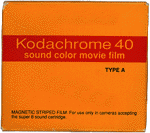
50' Kodachrome Sound - Type A | Discontinued |
EI 40 |
| 50' Kodachrome Sound - Type G | Discontinued |
EI 40 |
| 200' Kodachrome Sound | Discontinued |
EI 40 |
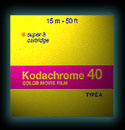
50'Kodachrome Silent | Still Produced
(~$30Cda(processing included)/$15US) |
EI 40 |
| 50' Ektachrome Silent | Discontinued | EI 160 |
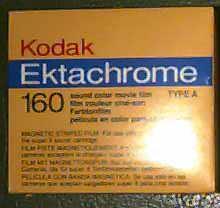
50'Ektachrome Sound | Discontinued |
EI 160 |
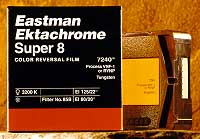
50'Ektachrome 7240 Silent | Still Produced(~$20Cda/$15US) |
EI 125 |
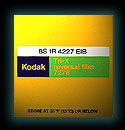
50'Tri-X(Black & White) Silent | Still Produced(~$15Cda/$10US) |
EI 160 |

50' 4X (Black & White) Silent | Discontinued |
EI ?? |
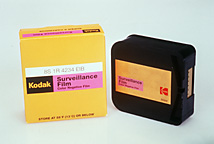
50'Surveillance Film | Not available to the public
(or so i hear) |
EI 200 |
Tri-X(7278) Technical/Professional Information Page
Ektachrome(7240) Technical/Professional Information Page
 Kodak's New Super 8 Webpage!!
Kodak's New Super 8 Webpage!!
To buy any of this films call Kodak at 1-800-621-FILM
-- G e t t i n g S t a r t e d --
Getting started it in Super 8 is not very hard or very expensive.
All you really need is a camera and a projector. Neither
are made anymore so they must be bought used(this is very cheap).
Cameras - To find a camera all you have to do is hang around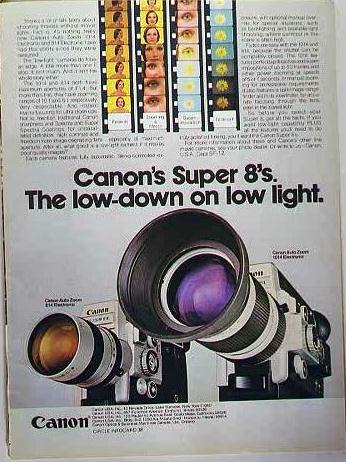 flea markets, garage sales and goodwill/thrift shops for a few
weeks and eventually you will find one. You should expect to
pay between $5 and $30, anything over $45 should not really
be considered unless it is of the highest quality or you need
a professional camera. You should look for a sound camera
if possible(I know kodak sound film has run out) because
sound cameras are usually newer and have more features. A
zoom lens it pretty much necissary and a camera should not
be bought without one, also built-in light meters, single
frame filming, macro lenses and other such options come in handy
more than you would think. Good names to look for are Minolta,
Kodak, Bolex, Eumig, Beaulieu and most well known camera
companies.
flea markets, garage sales and goodwill/thrift shops for a few
weeks and eventually you will find one. You should expect to
pay between $5 and $30, anything over $45 should not really
be considered unless it is of the highest quality or you need
a professional camera. You should look for a sound camera
if possible(I know kodak sound film has run out) because
sound cameras are usually newer and have more features. A
zoom lens it pretty much necissary and a camera should not
be bought without one, also built-in light meters, single
frame filming, macro lenses and other such options come in handy
more than you would think. Good names to look for are Minolta,
Kodak, Bolex, Eumig, Beaulieu and most well known camera
companies.
Projectors - There is a wide range of projectors out there.
Before you make up your mind on one there are several
things to look for. What kind of bulb does it use(bulb
prices can range from $5-$65)? Is it a sound projector?
Does it have a very sharp lens? Does it have nifty features
such as autothreading, slow motion or compatablitywith
Regular-8? You can expect to pay about $8-$35 for projectors.
Film - Film is sort of relativly cheap(but when compared to 35mm
it is very cheap) and $28Cda/$20US for 1 roll of Kodachrome
+ processing isn't bad. When you first get your new camera
shoot a test roll, it can be of anything you want and on
film you want(for a first roll, if you are not too sure if
the camera works at all use a b&w film because it costs less).
When you going to choose film there are several choices:
1)Kodachrome(KMA-594), Kodachrome is a very good looking
film with lots of color and good grain and an exposure
index(EI/ASA) of 40. Kodachrome is also cheaper than Ektachrome
even though it is a better film. This film is processed by
Kodak.
2)Ektachrome VNF-1(7240), Ektachrome is a video news film
designed for use in documentaries but works with any application,
Ektachrome is a fair grained film with good blues, reds, and
dark colors but it sometimes has a hard time with greens in
lower light, Ektachrome has an EI of 125. Kodak does not process
this film.
3)Tri-X (TXR-464), TriX is a black and white film with a very
good grain and contrast, some automatic cameras(such as mine)
will over expose TriX so it is a good idea to test it first,
Tri-X has an EI of 160
4)Plus-X, Plus-X is very similar to Tri-X except it has a finer
grain and it has an EI of 40. Kodak does not process either of these
films.
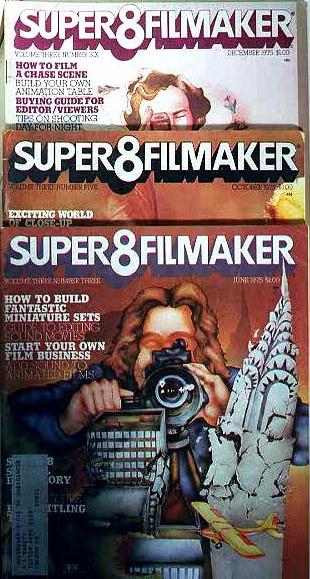 -- P r o c e s s i n g --
-- P r o c e s s i n g --
To get your super 8 Kodachrome film developed you have to buy
a kodak pk-59 mailer which will send it to Kodak, who then sends
it to Switzerland where it sits 2-3 weeks(being developed and such)
then they send it back to Kodak in the US then to your home.
In Canada and Australia the price of Kodachrome includes processing,
and you just put the film into the little envelope that comes in
the box of film and send it away. Kodak, however does not do a real
great job of handling their film. If it gets developed it will come
back fine,but I have heard stories of it coming back completely
exposed or even undeveloped. I have recently heard from a few
people that Fuji will develop Kodachrome for $7.50 in the USA,
here is the address:
Fuji Color Processing
3259 East Harbour Drive
Suite 200
Phoenix, AZ 85034
Attn:Michelle (Super 8 Film)
Phone: 1-800-224-5227 ext 103
Unlike Kodachrome, Kodak does not process their own Ektacrome
film(Process RVNP),to get your Super 8 Ektachrome 7240 film
developed just look in your phonebook for a local camera/film
store and chances are one of them will develop your film for
about $8-$15. The place I go to is located in Calgary Albert
and it costs $11.50 cdn for Ekta-7240 or Tri-X:
Local Lab Film Services Ltd.
A4634 6a St
Calgary Alberta Canada
T2E 4B5
Phone: (403)277-3092
-- Y o u r F i r s t M o v i e --
The Following From GAF super 8 movie camera ST/101 Instuctions
Tips For Better Home Movies(Copyright 1970 GAF Corperation)
- MAKE FILMS MORE INTERESTING - Make films more entertaining
by telling a story with the camera, instead of just showing a
series of disconnected scenes. When filming a child's birthday
party, for example, include the following scenes to create a
simple story: getting up in the morning, the beginning of the
"great day" - wrapping presents - baking or buying the the birthday
cake - getting dressed for the party - arrival of guests - party
games - cutting the cake - guests leaving - cleaning up, etc.
Another Example: To turn a travel movie into a story, include(in
addition to the usual "tourist attractions") scenes showing personal
aspects of the trip: the family getting ready - leaving home - overnight
stips - roadside restaurants - shopping for gifts - local people - heading for home,etc.
- UTILIZE THE ZOOM LENS - Shoot several scenes of each subject, some at
the wide angle, others at the normal and telephoto settings. Vary overall views with close-ups in each scene.
- VARY SCENES - Do not make movies in sunny weather only. Scenes made on cloudy days, even in rain, add variety, make the movie more interesting. Mixing indoor and outdoor scenes aslo helps.
- EDIT YOUR MOVIES - It is more fun to watch edited movies. As returned from the processor, the film often contains too much material. Use an inexpensive editor splicer(available at photo dealers) to assemble the best parts into an effective sequence.
- USE TITLES - Titles connect scenes into a smoothe-flowing presentation. Camera stores sell a variety of titling outfits. Follow the intructions provided with the titler. Good Titles can also be made without a titler, by including close-ups of signs. Practically every place has a sign that can be used as a title. In addition, road and street signs, billboards, and mailboxes can be utilitized to identify and describe subjects
The Following From Minolta XL-Sound 64 Owner's Manual
Tips For Better Sound/Silent Movies(Copyright 1979 Minolta Camera Co)
- SOUND PICKUP AND RECORDING - Your movies can take on much greater realism and excitement with the added dimention of sound. Techniques for good sound in your movies are similar to those for good results with a tape recorder. The microphone should be placed as near to the sound source as convinient(perhaps concealed if you wish) at least one meter/three feet form the camera. If there is more than one sound source, the microphone should be placed so as to receive equal volume from each using a microphone extension cord if necessary. Where possible with musical instuments, the standard microphone should be suspended in position for best pickup and recording should be done at low amp-input level. Using a directional microphone may help to "focus" sound pickup in many instances and makes it unnecessary to hold a microphone. To narrate a scene while filming it, hold to camera and operate the trigger with one hand as you hold the standard microphone firmly off to the opposite side as far a practicable with the other. The microphone should be left in place or held still during recording to avoid distracting noises on the soundtrack. For best continuity, keep the camera pointed at the main subject even though there may be pertinent sounds from the sidelines or others speaking off camera. Distracting background noises such as traffic or machinery noises should be avoided, TV Sets, radios, etc., should be turned off unless they are necessary for the filming to be done. Do not rub, tap, or handle the mike or stroke the cord while recording. Rememeber that the sound is recorded on the film 18 frames(one second) ahead of the picture it goes with. For this reason, it is advisable to let the camera run for one or two seconds before and after importants sounds and/or actions. This prevents sound from the previous picture being played with a following unrelated scene.
- LIGHTING AND EXPOSURE - For best results, most outdoor filming should probably be done with the sun more or less behind you. However, occational inclusion of shots against the light, such as sparkling water or sunsets, etc., perhaps with subjects silhouetted against them can add beauty and brilliance to your movies. If you wish to emphasize the shadow areas of a backlighted scene - as if the sun is above and behind the person in a portrait - use the manual aperature control or automatic back-light control. This can also throw the bright areas more or less into overexposure for high-key effects. For existing-light color filming in usual rooms, results will generally be best when the lighting is kept fairly flat and the shadows not completely black but "filled in" with enough light to show details. This can be done by neutral reflecting surfaces, such as white tablecloths, walls, etc., near your subject. Generally, all the lights in a room should be turned on for the most pleasing existing-light filming, though most movies can be made at low light levels. As explained next, using a movie light not directly but "bounced" from a ceiling or wall with high speed film will produce a soft, flattering, natural looking supplementary lighting when existing light is too low or of unsatisfactory color.
- LENGTH OF SCENES - The length of individual scenes will naturally vary with conditions and effects desired, though with usual sound movies, it will probably depend mainly upon dialog or other important sounds to be recorded. Too many short scenes will be difficult to view and, particularly with sound, may be confusing and distracting. For a normal, easy-to-watch effect there should be long, medium and short scenes, and event with silent film, they should generally not be shorter than five to ten seconds. Consider the time needed for the scene to achieve its effect on the screen to determine how long you should shoot; shots to set the scene (show to locate) or record simple action, for example generally require less time that detailed close-ups, extended speech, or subtle or complicated action.
- PANNING - Moving the camera while filming is called panning, and your movies will probably be more satisfactory if you use this technique sparingly. It can be used to advantage to follow a moving subject by keeping it centered in the viewfinder. When used to cover a panorama or extended subject, it is most important to move the camera smoothly and not too fast(at least 15-20 seconds should generally be taken to cover a 90 degree angle), perhaps filming for a few seconds with the camera stationary before beginning and ending the pan. A cine tripod with pan head will help you make better pans.
The Kodachrome 40 Processing Mailer(PK-59)
Sign My Guestbook
 View My Guestbook
View My Guestbook

Make Money, join our webmaster link program.
Super 8 Stuff For Sale
To get your ad listed here contact me at bruntond@cadvision.com,
its free
---------------
8mm, Beaulieu, 6008S, Used
$1,800.00 firm
Description
Beaulieu 6008 S Super 8 Pro- Features Beaulieu Schneider
1.4/6-70 Zoom Lens, filming speeds at 4, 9, 18, 24/25, 36,
and 80 fps. Single frame also. Time lapse filming possible
at 3 speeds. Absolutley mint condition, with custom hard
case that can be thrown in the ocean (no extra charge, but
valued at 200 bucks) synchro quartz system, top of the Super 8
line, they've even shot features w/this one. This is no toy!
Hate to let it go. Paid 2100, will only sell for 1800.
Serious inquiries only. Buyer will be responsible for shipping
and handling...COD is fine...UPS accepts cash, check, money
order, and certified checks.
Contact e-mail to: Cmragz@aol.com
----------------
If you have any super 8 equipment for sale please email
Sherry Alwell at salwell@openvision.net
-----------------
From: Michael W Rosenzweig rosekiss@wwa.com
http://shoga.wwa.com/~rosekiss/
Posted: November 30th, 1998
For Sale: Kodachrome 40 Super 8 Sound color movie film, KMA 594,
CAT #157 5091 (50 foot, sound cartridges). Price includes
processing, (PK59Prepaid Kodak Premium Film Processing mailer
included with each roll).Special Note:Film was purchased on
March 9th, 1998 directly from Kodak and is being kept
refrigerated. It is dated to be processed before 02/1999.
The PK59mailers are valid through 4/30/99, are for use only
in the UnitedStates, and require postage for 3 ounces.
Film is all from the samebatch. These are 50 ft. sound
cartridges and will not fit in a silentcamera. Film speed
is ISO 25 in Daylight with camera filter, and ISO 40 with
movie light.Terms:$20 per roll, includes film and processing.
Add $3.00 per order for UPSinsured shipping anywhere in
the continental U.S. Payments by check willbe shipped when
check clears (about 10 days). Payment by money orderwill be
shipped next business day.
Confirm availability by email to: rosekiss@wwa.com
As of 11/30/98, I have 15 rolls left to sell.
-----------------
I was not able to answer this question perhaps
someone else could:
Dear sir ,we are a film club and we would appreciate it if
you could advise or send us some addresses\web site of
companies that specialises in telecine equipment for 8,super 8
and 16 mm film.( new or preloved) would dearly appreciate
your help , at the moment we are using a nordmende 8,super 8 .
that is on its last leg,again would appreciate an address/web
site of a company dealing with parts for the nordmende telecine
converter.
If you have the answer please contace Rudy at scorpio@gravity.net.au
-----------------
WANTED: Scipio Super8 Sound Philips 3302/Norelco 150 Pulse sync
cassetterecorder with reslover.
or
Super8 Sound Uher CR134 Pulse sync cassette recorder with reslover.
or
Optasound 116R Pulse sync cassette recorder with reslover.
Thanks E-mail: GManno@aol.com

Super 8 Links
- Super 8 on a budget
- A very very good page check this one out first
- Super 8 Sound
- Super 8 Sound sells its own brand of sound striped cartridges
- Through The Lens
- A newsletter devoted to Super 8
- Flicker
- Homepage of the Flicker Super 8mm Film Festival
- The Super 8 Sound Film Letter
- Print this letter and send it to Kodak to complain about the discontinuation of Sound striped film
- The Super 8 Newsgroup(alt.movies.cinematography.super8)
- Lots of information here!
- The Eastman Kodak Homepage
- There is a bit of information on super 8 at Kodak
- Super 8 Equipment Site
- This page has s8 equipment for sale!
- S8 Reversal Process
- This page explains how to develop TRI-X film at home
- Processing your own movies
- This page also explains how to process Super 8 film
- Tripod(This page's host)
- Free Web Pages!
- Online Shopping
- Visit my online shopping page to find stuff from CD-Now, Amazon, Spree, and more!
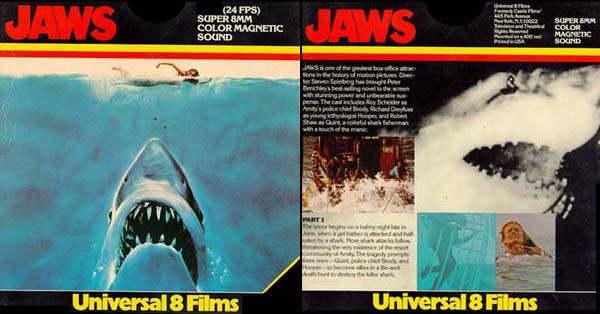
This page has been visited  times since March '98.
times since March '98.
Click on the graphic to vote for this
page as a Starting Point Hot Site.
This page's netword is: Super 8mm
This page by:Joe Brunton - Last modified Feb 10/99
bruntond@cadvision.com




-- W h a t i s S u p e r 8? -- So, what is super 8 you ask? Technically Super 8 is a 8mm wide piece of film. But to some it is much more. In the right hands it becomes an art form. A way to express ideas, thoughts, and feelings. "Many of today's great cinematographers and directors began their careers decades ago, at the counter of their local photo shop, buying a cartridge of Super 8 film." - Kodak's Super 8 Web Site "If a picture is worth a thousand words,a motion picture must be worth 10 times that" - Jason Publack
 leaving only Kodak. Kodak has since stopped production of sound
cartridges and alot of their Kodachrome and Ektachrome
lines.
leaving only Kodak. Kodak has since stopped production of sound
cartridges and alot of their Kodachrome and Ektachrome
lines.







 Kodak's New Super 8 Webpage!!
Kodak's New Super 8 Webpage!!
 flea markets, garage sales and goodwill/thrift shops for a few
weeks and eventually you will find one. You should expect to
pay between $5 and $30, anything over $45 should not really
be considered unless it is of the highest quality or you need
a professional camera. You should look for a sound camera
if possible(I know kodak sound film has run out) because
sound cameras are usually newer and have more features. A
zoom lens it pretty much necissary and a camera should not
be bought without one, also built-in light meters, single
frame filming, macro lenses and other such options come in handy
more than you would think. Good names to look for are Minolta,
Kodak, Bolex, Eumig, Beaulieu and most well known camera
companies.
flea markets, garage sales and goodwill/thrift shops for a few
weeks and eventually you will find one. You should expect to
pay between $5 and $30, anything over $45 should not really
be considered unless it is of the highest quality or you need
a professional camera. You should look for a sound camera
if possible(I know kodak sound film has run out) because
sound cameras are usually newer and have more features. A
zoom lens it pretty much necissary and a camera should not
be bought without one, also built-in light meters, single
frame filming, macro lenses and other such options come in handy
more than you would think. Good names to look for are Minolta,
Kodak, Bolex, Eumig, Beaulieu and most well known camera
companies. -- P r o c e s s i n g --
-- P r o c e s s i n g --


